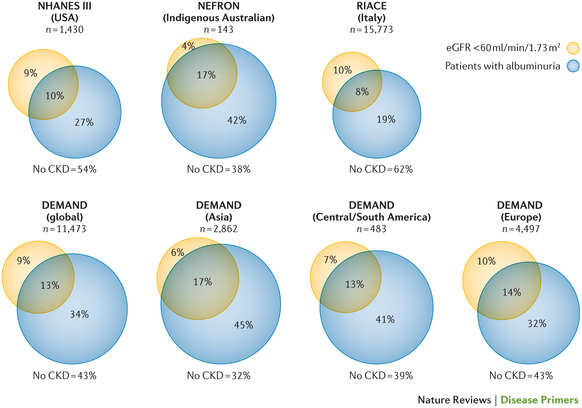Review Abstract
糖尿病性腎症
Diabetic kidney disease
2015年7月30日 Nature Reviews Disease Primers Article number: 15018 (2015) doi: 10.1038/nrdp.2015.18

腎臓は、糖尿病における微小血管損傷の最も重要な標的であるといって過言ではない。非常に多くの糖尿病患者が、この疾患および/または高血圧などの他の共存症や加齢に伴うネフロンの減少によって腎臓病を発症する。慢性腎臓病(CKD)が存在し、重症の患者では、有害健康転帰および早期死亡のリスク上昇が認められる。そのため、糖尿病患者のCKDの予防と管理は、現在の糖尿病患者の総合的管理における主要な目的となっている。糖尿病患者の厳格な管理として、レニン-アンジオテンシン-アルドステロン系の阻害をはじめ、血糖値や血圧の管理が行われる;これらのアプローチによって、糖尿病性腎症(DKD)の発症率が低下し、進行が遅延する。実際この30年間、DKDの発症率は大きく減少しており、糖尿病ケアの改善が、患者の予後の改善の主な原因になっている。しかし、DKDの予防、進行停止、治療および回復を目的とした革新的な治療戦略に必要なアンメットニーズはまだ残されている。このPrimerでは、糖尿病患者におけるCKDの分子病態および進行に関係する主な経路と標的について現在の知見を要約する。さらに、DKDの予防と管理に関する最新のエビデンスについて、多くの議論も交えて解説する。最後に、専門重点研究に直ちに必要な投資を行うことで、新しい介入方法が開発できる可能性を模索する。
The kidney is arguably the most important target of microvascular damage in diabetes. A substantial proportion of individuals with diabetes will develop kidney disease owing to their disease and/or other co-morbidity, including hypertension and ageing-related nephron loss. The presence and severity of chronic kidney disease (CKD) identify individuals who are at increased risk of adverse health outcomes and premature mortality. Consequently, preventing and managing CKD in patients with diabetes is now a key aim of their overall management. Intensive management of patients with diabetes includes controlling blood glucose levels and blood pressure as well as blockade of the renin–angiotensin–aldosterone system; these approaches will reduce the incidence of diabetic kidney disease and slow its progression. Indeed, the major decline in the incidence of diabetic kidney disease (DKD) over the past 30 years and improved patient prognosis are largely attributable to improved diabetes care. However, there remains an unmet need for innovative treatment strategies to prevent, arrest, treat and reverse DKD. In this Primer, we summarize what is now known about the molecular pathogenesis of CKD in patients with diabetes and the key pathways and targets implicated in its progression. In addition, we discuss the current evidence for the prevention and management of DKD as well as the many controversies. Finally, we explore the opportunities to develop new interventions through urgently needed investment in dedicated and focused research. For an illustrated summary of this Primer, visit: http://nature.asia/1KREpDq

